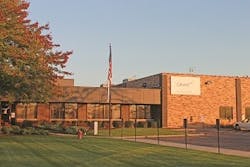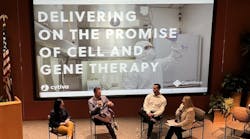LEGACY OF INNOVATION
The Woodstock facility has a long history serving the pharmaceutical industry. The original company was founded in 1968 as Automatic Liquid Packaging (ALP) in Elk Grove Village, Illinois. By 1980 ALP headed west to Woodstock, building a new facility to house four BFS lines — intended primarily to demonstrate the efficacy of BFS technology to customers. This eventually created demand for contract manufacturing services, which the company pursued with vigor. The facility’s first production runs started in 1982 with approximately 60 employees working three shifts, five days a week to meet the demand. Fast forward to 1999; Cardinal Health purchases the business, and in 2007 Cardinal Health PTS becomes Catalent Pharma Solutions.
As of 2014, Catalent offers extensive aseptic, glass-free BFS filling-solution capabilities and capacity with experience providing development through commercial scale manufacturing support covering single and multi-dose solutions across complex emulsions and suspensions. “For more than 30 years here on site,” says David Bricker, Catalent’s site general manager, “We’ve specialized in the ‘hard to do’ complex molecules — we can do both, but it’s really the complex molecules we do well.” Bricker explains Catalent has a strong representation in the ophthalmic, respiratory, topical and biotech market spaces.
Shown here is a conveyor leaving the BFS machine that carries finished products; its control panel, which is in the secondary handling space monitors BFS parameters and environmental conditions.
A main focus for Catalent is in the formulation and development areas. “It’s not just the straightforward solutions, but really we are able to simplify the complex molecules and produce them with the same operational excellence as the simple solutions,” says Natasha Hults, director of R&D. “For example, we’ve been successfully producing a biologic in BFS for over 20 years, so we have a long, proven history of how to handle a wide range of molecules, including complex and large molecule products.”Since its inception, the company’s owners have continuously invested in the facility and the BFS technology it encompasses. Currently the plant, at some 500,000 sq. ft., encompasses a total of 38 BFS lines. Since 2011, Catalent has invested a significant amount of capital and plans to further expand and improve operations over the next three years. These investments are paying off — especially in the area of quality. Through the guidance and institutionalization of Catalent’s Quality Management System, organization and continuous attention to operational excellence, the site’s regulatory profile has steadily improved, and in 2013 the company experienced zero FDA 483 observations. Bricker agrees that as Catalent’s organizational methods and processes were institutionalized the plant’s quality performance has improved markedly.
OPERATIONAL IMPROVEMENTS ON DECK
It’s obvious wherever you observe Catalent and its production assets, whether it’s the biotechnologies and biopharmaceuticals, solid dose development or cutting-edge aseptic filling, operational excellence is a priority. For the Woodstock facility, its excellence culture is being manifested in the first phase of its planned multi-million-dollar investment. “There are some things we need to do from an infrastructure standpoint,” explains Bricker, “to provide continuous improvement and continue to meet the current and future cGMP standards.” Characterizing the first phase as a “nice project,” Bricker’s description is apt because very targeted dollars are supporting some well-defined, high-value operational improvements. Bricker describes it as a “refresh” with Catalent better aligning the facility to “take advantage, and leverage the BFS technology for [the] injectable marketplace.”
Shown here: the redundant sterile filtration and buffer tank that feeds the fill nozzles on the inside of the BFS machine.
The site has a classic feel, after all, its administrative, corporate front and original manufacturing and logistic spaces were built in 1980. But in this case “classic” is relative, more like a vintage car. With 30 years of BFS experience within the context of a nearly continuous history of expansion and infrastructure improvement, Catalent knows a thing or two about leveraging BFS technology within the ecology of its operational footprint. But that doesn’t mean opportunities for improvement have all been exploited. Upcoming capital spending is intended, says Bricker, to provide additional administrative and operational control that will support the facility’s ability to support BFS process flexibility and market expansion. “When you look at the BFS technology from a parenteral manufacturing standpoint, as well as what has been taking place quality-wise on the traditional glass vial side,” notes Catalent’s commercial operations director Eric Feltes, “the automatic, aseptic filling technology of BFS addresses many of those root causes of challenges in the parenterals market.” Looking at it from a technology standpoint, says Feltes, BFS really has true advantages, especially in other market spaces, outside of ophthalmic and respiratory. So looking at those advances, particularly in the U.S. parenteral space, we see as a growth opportunity for the technology as well as for us as an organization.”PLASTIC AND FANTASTIC
Blow/Fill/Seal technology, pioneered by Weiler Engineering and operationally perfected by Weiler’s ALP and eventually Catalent, offers a number of specific advantages over glass injectable drug containers. To a great degree, the process’s automated sterile operations reduce opportunities for contamination and drive out risk, “by orders of magnitude,” says Catalent. The elimination of human intervention and glass handling prior to fill are huge drivers in this reduction. In particular, there are several different studies that support the drastic reduction of foreign particulates and even a risk assessment by industry experts that qualify BFS as 100 times lower risk than traditional glass vial filling. “This technology really drives out a lot of the root causes of foreign particulates — even the exposure time that glass containers have — it’s minimized; you’re controlling or even eliminating it,” says Feltes. He explains that BFS, through quality-by-design principles and automation, “drives out, via the design of the process, the different variables that impact quality.”
Inside Catalent BSF: the Parison head, the primary functional component of the process
In its pursuit of the sterile injectables market, Catalent recently introduced its ADVASEPT advanced aseptic glass-free delivery solution, a platform that is directly associated with the capital investments being made at the Woodstock facility. Touting enhanced sterility assurance, lower risk and greatly reduced contamination potential of their new design, ADVASEPT vials integrate the stopper and a sealing system that eliminates metal tabs or lids. Catalent says its container system provides high performance characteristics and that the process itself does not impact biologics negatively or affect the stability of biologic compounds tested. Additionally, there is an ongoing study measuring the effects on stability of a monoclonal antibody in glass vs. the ADVASEPT vial that shows comparable results. Catalent has performed controlled extraction studies on ADVASEPT primary and secondary packaging components. Six leachables methods have been validated to cover analysis of any known extractables in both water and saline formulations. Along with the BFS vials, Catalent offers integrated services that will accelerate the conversion from glass to aseptic BFS technology.• Over 450,000 sq ft of production, laboratory, R&D, packaging, warehouse and administrative space
• Fill volumes range from .3 mL to 1 L
• World-class critical utility systems including water for injection
• Cold-storage capabilities
• Solutions for products that are temperature, light-, oxygen-, or delivery-sensitive
• Analytical and microbiology laboratories
• 38 B/F/S lines working 24/7
From its role providing flexible BFS packaging and fill and finish operations to critical phase I, II and III and commercial scale-up development support, Catalent’s Woodstock facility maintains a leadership role in bringing better operational methodologies to the pharmaceutical industry. Its customers come to the organization to help them meet the challenges they have in bringing their molecules to market while taking advantage of the design freedom of the primary container closer. Catalent’s customers are motivated to do business with the company for a variety of reasons, but for many, risk mitigation is an imperative — one that is served well by depending on an experienced operational expert — especially if a client’s compounds as well as its customers are better served by safer, more available and less expensive medicines.






